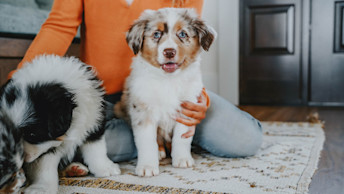October 29, 2024
When Do Puppies Start Teething? How to Help a Teething Puppy

When Do Puppies Start Teething?
Puppies typically begin teething around 3 weeks of age1, when their first baby teeth (also called milk teeth or deciduous teeth) start to emerge. However, the teething process can vary from pup to pup, and some may start a little earlier or later.
The first teeth to appear are usually the incisors1, the small front teeth used for nibbling and grooming. Over the next few weeks, the rest of the puppy's baby teeth will gradually come in, including the canine teeth (fangs) and premolars.
By around 6 weeks old, most puppies will have a full set of 28 baby teeth1. This is when the teething process really kicks into high gear, and you may notice your pup chewing on everything in sight to relieve the discomfort and pressure in their gums.
Some common signs that your puppy is teething:
- Excessive drooling
- Chewing on household items, toys, or your hands and feet
- Red or inflamed gums
- Crying or whining
- Finding small teeth on the floor as they lose their baby teeth
- Small blood spots on chew toys or bedding as new teeth break through
If you notice these behaviors, it's a good indication that your furry friend's teeth are coming in and causing them some discomfort.
How to Help a Teething Puppy
One of the best ways to help your puppy through the teething process is to provide plenty of safe, appropriate chew toys. Puppies have an instinctual need to chew as their new teeth emerge, and giving them acceptable outlets can prevent them from destroying household items, developing problematic chewing habits, or chewing unsafe items like power cords.
Recommended chew toys for teething puppies:
- Rubber chew toys (like Kongs or Nylabones)
- Edible chews (bully sticks, antlers, or no-hide chews)
- Frozen chew toys or frozen, wet washcloths
- Chew toys with different textures and shapes
When introducing new chew toys, make it an exciting event! Let your puppy sniff and investigate the toy, then offer praise and treats when they start chewing on it. This positive reinforcement helps them learn which items are approved for chewing.
It's also helpful to rotate your puppy's chew toys regularly. Having a variety of toys with different shapes, textures, and flavours can keep them engaged and interested.
Put a few toys away for a week or two, then reintroduce them as "new" items to recapture your puppy's attention.
Remember, supervision is key when giving your teething puppy any chew toy. Monitor them closely to ensure they don't break off and ingest small pieces, which could cause an intestinal blockage or other health issues.
Managing Excessive Chewing
During the teething phase, your puppy's urge to chew can become excessive and destructive. To prevent damage to your belongings and furniture, it's essential to manage this behavior proactively. One effective solution is using bitter spray deterrents. These sprays are formulated with a safe but unpleasant taste that discourages chewing on surfaces you've treated.
Another strategy is confining your puppy to a puppy-proofed area when you can't supervise them directly. This could be a crate or a secured room with no access to off-limits items. Providing plenty of appropriate chew toys in this area can help redirect their chewing instincts to acceptable outlets.

Positive reinforcement training can also be a powerful tool in managing excessive chewing. When you catch your puppy chewing on an approved toy or object, praise and reward them with treats or affection. This reinforces the desired behavior and helps them understand what's acceptable to chew on. Consistency and patience are key when using this training approach.
How Long Does Puppy Teething Last?
The teething phase for puppies typically lasts around 6 months1. However, the duration can vary depending on the breed and individual puppy.
Puppy teething timeline:
- Puppies are born without any teeth and their first set of deciduous (baby) teeth starts to emerge around 3 weeks old.
- By 6 weeks, most puppies will have their full set of 28 baby teeth.
- Around 12 weeks old, the puppy teething process begins as the permanent adult teeth start pushing through the gums and pushing out the baby teeth.
- This process continues until around 6 months of age when all 42 adult teeth have fully erupted.
The entire teething phase can be uncomfortable for puppies as the new teeth emerge and old teeth are lost. Providing appropriate chew toys and monitoring for any issues at each stage is important during this time.
When Teething is Over
Puppy teething typically ends around 6 months of age when all 42 of their permanent adult teeth have erupted.
With their new adult teeth, you'll want to start implementing a dental care routine to keep their teeth and gums healthy. This includes brushing their teeth regularly with a dog-safe toothpaste and scheduling regular professional cleanings with your vet.
Establishing good dental care habits early on can help prevent dental problems and ensure your puppy maintains a healthy, pain-free mouth throughout their life.
While you may miss those adorable puppy teeth, having their full set of permanent chompers is an exciting milestone! Your pup can now enjoy harder chew toys and their teeth will be set for many years of happy chewing.
“Teeth, Teething and Chewing in Puppies.” VCA Animal Hospitals. Accessed September 27, 2024. https://vcacanada.com/know-your-pet/teeth-teething-and-chewing-in-puppies.



